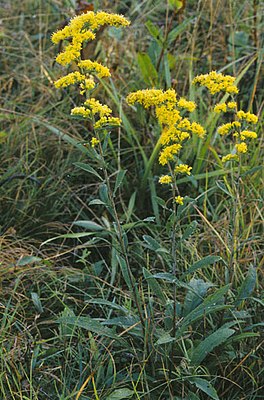Grove goldenrod
| Grove goldenrod | ||||||||||||
|---|---|---|---|---|---|---|---|---|---|---|---|---|

Grove goldenrod ( Solidago nemoralis ) |
||||||||||||
| Systematics | ||||||||||||
|
||||||||||||
| Scientific name | ||||||||||||
| Solidago nemoralis | ||||||||||||
| Aiton |
The grove goldenrod ( Solidago nemoralis ), usually called gray goldenrod , is a species of the genus of goldenrod ( Solidago nemoralis ) within the sunflower family (Asteraceae).
description
Vegetative characteristics
Solidago nemoralis grows as a perennial herbaceous plant that reaches heights of 20 to 100 centimeters and is one of the smaller goldenrod species. It has one to really upright stems , sometimes more. The stem is reddish to gray-green and has lines with short, white hairs.
The leaves are arranged alternately on the stem. The lower leaves are up to 10 centimeters long. The leaves in the upper half of the stem are narrower, shorter and have no stems.
Generative characteristics
The flowering time in North America is in late summer and autumn. The pyramidal, branched total inflorescence usually contains many (10 to 300) cup-shaped partial inflorescences . The cup shafts are 2 to 3.5 millimeters long. Up to four cover sheets are linear or may be missing.
The flower heads are narrow-bell-shaped with a length of 2.6 to 5.8 millimeters and have a diameter of 1.7 to 10 millimeters. In the involucrum, bracts are arranged in three rows. The unequal bracts are ovate to linear-lanceolate; the outer ends pointed and the inner blunt. In the flower head there are usually five to eleven ray-florets at the edge and three to ten tubular florets (disc florets) in the center. In the zygomorphic , female, fertile , yellow ray florets, crown tongues are 2.8 to 5.5 millimeters wide and 0.3 to 0.7 millimeters wide. The radially symmetrical, yellow, hermaphrodite, fertile tubular flowers are 2.5 to 4.6 millimeters long and end in five 0.4 to 0.6 millimeter long crown teeth.
With a length of 0.5 to 2 millimeters, the ribbed achenes are obverse -conical and curly-haired. The bristles are in two rows in the 2 to 4 millimeter long pappus .
Occurrence
Solidago nemoralis is widespread in North America in Canada (all provinces except Newfoundland and Labrador ) and in the United States (all states wholly or partially east of the Rocky Mountains ). There are localities for the Canadian provinces of Québec, Nova Scotia, Ontario, Prince Edward Island, New Brunswick, Saskatchewan, Alberta, Manitoba and southeastern British Columbia and for the US states Connecticut, Indiana, Maine, Massachusetts, Michigan, New Hampshire, New Jersey, New York, Ohio, Pennsylvania, Rhode Island, Vermont, West Virginia, Illinois, Iowa, Kansas, Minnesota, Missouri, Nebraska, North Dakota, Oklahoma, South Dakota, Wisconsin, Colorado, Montana, eastern Wyoming, Alabama, Arkansas, Delaware, Florida, Georgia, Kentucky, Louisiana, Maryland, Mississippi, North Carolina, South Carolina, Tennessee, Virginia, District of Columbia, New Mexico, and Texas.
Solidago nemoralis grows in forests, prairies, grasslands, wasteland, and roadsides. She is a pioneer species.
Solidago nemoralis is an invasive plant in Switzerland . Due to its spreading potential and the damage in the areas of biodiversity , health and economy, it was included in the black list of invasive neophytes in Switzerland and made subject to the Release Ordinance.

Systematics
The first publication of Solidago nemoralis was made in 1789 by William Aiton in Hortus Kewensis; or, a catalog ... , 3, page 213.
From Solidago nemoralis There are two subspecies:
- Solidago nemoralis subsp. decemflora (DC.) Brammall ex Semple (Syn .: Solidago decemflora DC. , Solidago longipetiolata Mack. & Bush , Solidago pulcherrima A.Nelson , Solidago nemoralis var. decemflora (DC.) Fernald , Solidago nemoralis var. longipetiolata (Mack. & Bush) EJPalmer & Steyerm. , Solidago nemoralis subsp. Longipetiolata (Mack. & Bush) GWDouglas ): It is tetraploid with 2n = 36.
- Solidago nemoralis Aiton nemoralis (Syn .: Solidago nemoralis . Var arenicola Burgess , Solidago nemoralis var. Elongata Peck , Solidago nemoralis var. Haleana Fernald ): There are diploid and tetraploid populations with 2n = 18 or 36.
swell
- John C. Semple, Rachel E. Cook: Solidago Linnaeus. In: Flora of North America Editorial Committee (Ed.): Flora of North America North of Mexico. Volume 20: Magnoliophyta: Asteridae, part 7: Asteraceae, part 2 (Astereae, Senecioneae). Oxford University Press, New York and Oxford, 2006, ISBN 0-19-530564-7 . Solidago nemoralis , p. 159 - the same text online as the printed work.
Individual evidence
- ^ A b Solidago nemoralis in the Germplasm Resources Information Network (GRIN), USDA , ARS , National Genetic Resources Program. National Germplasm Resources Laboratory, Beltsville, Maryland. Retrieved August 14, 2019.
- ↑ a b c d e f g h John C. Semple, Rachel E. Cook: Solidago Linnaeus. In: Flora of North America Editorial Committee (Ed.): Flora of North America North of Mexico. Volume 20: Magnoliophyta: Asteridae, part 7: Asteraceae, part 2 (Astereae, Senecioneae). Oxford University Press, New York and Oxford, 2006, ISBN 0-19-530564-7 . Solidago nemoralis , p. 159 - the same text online as the printed work.
- ↑ a b USDA NRCS (Ed.): Plant Fact Sheet - GRAY GOLDENROD Solidago nemoralis Aiton . ( usda.gov [PDF]).
- ^ Federal Office for the Environment FOEN: Invasive Alien Species . ( admin.ch [accessed on August 10, 2019]).
- ↑ S. Buholzer, M. Nobis, N. Schoenenberger, S. Rometsch: List of the alien invasive plants of Switzerland . Ed .: Infoflora. ( infoflora.ch [accessed on August 10, 2019]).
- ↑ Invasive neophytes | Grove goldenrod. JardinSuisse, accessed on August 11, 2019 .
- ↑ Solidago nemoralis at Tropicos.org. Missouri Botanical Garden, St. Louis, Retrieved August 14, 2019.
Web links
- Distribution map of North America. BONAP, accessed in 2019 .
- Warning list of possible invasive species in Bavaria - PDF.


